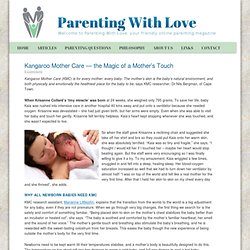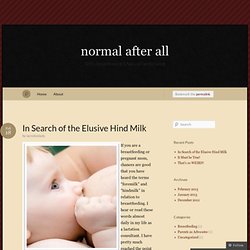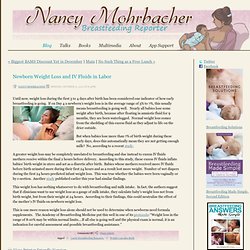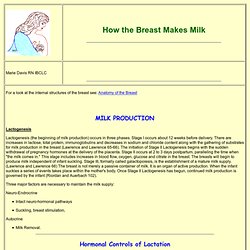

How To Put On Nipple Shields. Cranial-Sacral Therapy: When Can It Help. Eating Dairy-Free? Never fear!

Who_s_20Who_20Bro-FINAL.pdf. Kangaroo Mother Care — the Magic of a Mother’s Touch. Kangaroo Mother Care (KMC) is for every mother; every baby.

The mother’s skin is the baby’s natural environment, and both physically and emotionally the healthiest place for the baby to be, says KMC researcher, Dr Nils Bergman, of Cape Town. When Krisanne Collard’s ‘tiny miracle’ was born at 24 weeks, she weighed only 795 grams. To save her life, baby Kaia was rushed into intensive care in another hospital 40 kms away and put onto a ventilator because she needed oxygen. Krisanne was devastated – she had just given birth, but her arms were empty. Even when she was able to visit her baby and touch her gently, Krisanne felt terribly helpless. Susan Ludington's "KCBIB" For Premature Babies - Kangaroo Mother Care (KMC) has often been used as a treatment for premature or preterm babies.

In a rural third world situation where no incubators are available this method of caring for preterm or low birth weight babies can be life-saving. This works because the baby on the mother’s chest does not get cold, so the lungs function better. The baby in skin-to-skin contact also feels safe with mum’s familiar heart beat and voice so they do not become stressed and the heart rate, blood pressure and breathing stabilize faster.
On the mothers chest the baby also stimulates the production of breastmilk. This milk is vital for providing the preterm baby with the exact food needed to grow her brain. NW Newborn Clinical Guideline - Newborn Services Breastfeeding Latch Score. BAT. Mami-chapter-7-review-of-breastfeeding-assessment-tools. Moms turn to pills to help produce more breast milk. In Search of the Elusive Hind Milk. If you are a breastfeeding or pregnant mom, chances are good that you have heard the terms “foremilk” and “hindmilk” in relation to breastfeeding.

I hear or read these words almost daily in my life as a lactation consultant. I have pretty much reached the point where I want to rip my hair out every time I hear or see them. I first remember hearing the words about 12 years ago while working for another lactation consultant. 1746-4358-2-11. 9 Causes and 14 Remedies. What Parents Are Saying Oh my Goodness this product is absolutely FANTASTIC.

I was a bit leery of trying it out just because you never know what is real and what isn't but my husband and I were desperate. Our son was diagnosed with acid reflux at 4 months old and he was put on zantac for it. It helped with his spit up but not the pain. He was just in so much pain it got to the point where he associated his bottle with pain and it was a struggle to get him to eat. Congenital epulis: A rare benign tumor in the newborn Diniz MB, Giro Elisa MA, Zuanon Angela CC, Costa CA, Hebling J - J Indian Soc Pedod Prev Dent. Congenital epulis: A rare benign tumor in the newborn MB Diniz1, MA Giro Elisa2, CC Zuanon Angela2, CA Costa3, J Hebling2 1 PhD Student, Department of Pediatric Dentistry, School of Dentistry of Araraquara, Univ.

Estadual Paulista - UNESP, Araraquara, SP, Brazil2 Associate Professor, Department of Pediatric Dentistry, School of Dentistry of Araraquara, Univ. Estadual Paulista - UNESP, Araraquara, SP, Brazil3 Associate Professor, Department of Physiology and Pathology, School of Dentistry of Araraquara, Univ. Estadual Paulista - UNESP, Araraquara, SP, Brazil. Healthy Children's Center for Breastfeeding. Risks and ethics of breastmilk substitutes. “Infants who are not breastfed, for whatever reason, should receive special attention from the health and social welfare system since they constitute a risk group,” says the WHO.

When mothers do not breastfeed, they generally turn to infant breastmilk substitutes. The World Health Organization (WHO) and UNICEF recommend that health care providers inform parents about the health risks of artificial feeding and the benefits associated with breastmilk. The risks are numerous, but rarely is proper handling and preparation taken into consideration, “[...] Formula must be refrigerated and discarded after the first feeding attempt because it contains no antibodies or infection protection factors.”
Unlike breastmilk, breastmilk substitutes need to be carefully measured out based on its caloric content to ensure that your baby is getting the suggested portion. Breastfeeding Answers Made Simple - Breastfeeding Reporter - Newborn Weight Loss and IV Fluids in Labor. Until now, weight loss during the first 3 to 4 days after birth has been considered one indicator of how early breastfeeding is going.

If on Day 4 a newborn’s weight loss is in the average range of 5% to 7%, this usually means breastfeeding is going well. Nearly all babies lose some weight after birth, because after floating in amniotic fluid for 9 months, they are born waterlogged. Normal weight loss comes from the shedding of this excess fluid as they adjust to life on the drier outside. But when babies lose more than 7% of birth weight during these early days, does this automatically mean they are not getting enough milk? A greater weight loss may be completely unrelated to breastfeeding and due instead to excess IV fluids mothers receive within the final 2 hours before delivery. This weight loss has nothing whatsoever to do with breastfeeding and milk intake.
This is one more reason weight loss alone should not be used to determine when newborns need formula supplements. How the Breast Makes Milk. For a look at the internal structures of the breast see: Anatomy of the Breast Lactogenesis Lactogenesis (the beginning of milk production) occurs in three phases.

Stage I occurs about 12 weeks before delivery. There are increases in lactose, total protein, immunoglobulins and decreases in sodium and chloride content along with the gathering of substrates for milk production in the breast (Lawrence and Lawrence 65-66). The initiation of Stage II Lactogenesis begins with the sudden withdrawal of pregnancy hormones at the delivery of the placenta. Three major factors are necessary to maintain the milk supply: The Surgeon General’s Call to Action to Support Breastfeeding. PIF_Care_en.
Safe Use of Birth Control While Breastfeeding. Most women who breastfeed exclusively stop having menstrual periods. This is known as lactational amenorrhea. During lactational amenorrhea, the potential for ovulation is reduced. General breastfeeding webpages. Tongue tie. Treatments. Referals.